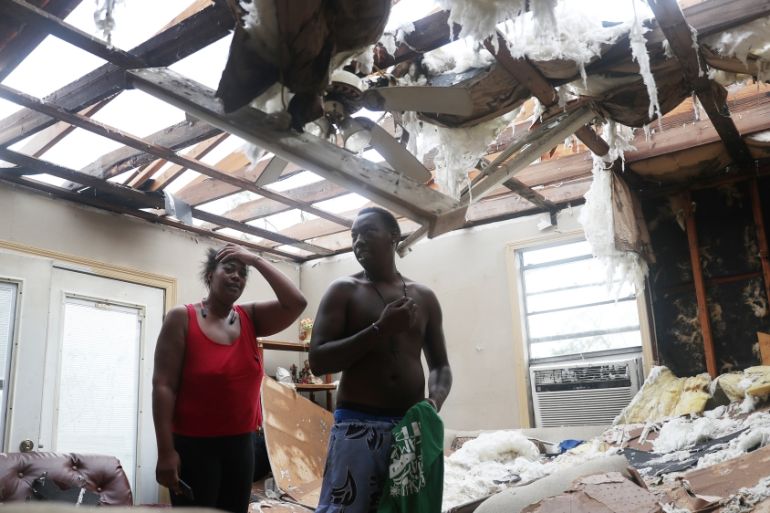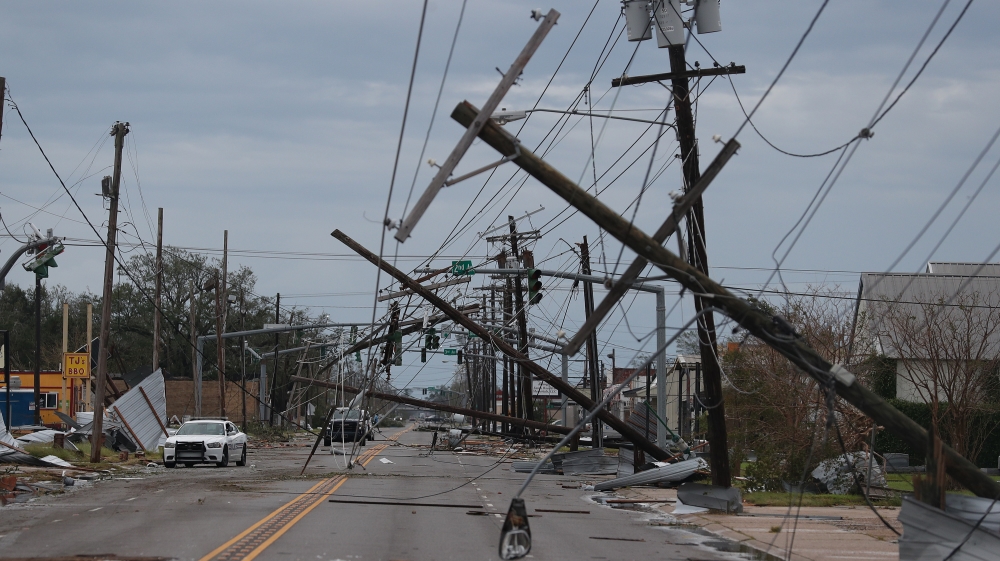Louisiana in ruins, 6 dead in wake of Laura as storm moves east
Residents of hard-hit Lake Charles, Louisiana, will return home to a city without electricity or running water.

The remnants of Hurricane Laura unleashed heavy rain and twisters hundreds of miles inland from a path of death and mangled buildings along the US Gulf Coast, and forecasters warn of new dangers as the tropical weather blows towards the Eastern Seaboard and the open water of the Atlantic Ocean.
Flooding and more tornadoes were possible as the leftovers of the once fearsome Category 4 hurricane move eastwards through Tennessee, Mississippi and Alabama on Friday after an apparent tornado tore through a church and homes in Arkansas on Thursday night. Laura weakened to a tropical depression late on Thursday, but could become a tropical storm again when it moves off the mid-Atlantic coast on Saturday.
Keep reading
list of 4 itemsAfter the Hurricane
World’s coral reefs face global bleaching crisis
Why is Germany maintaining economic ties with China?
More than 750,000 homes and businesses were without power in Louisiana, Texas and Arkansas in the storm’s wake, according to poweroutage.us, which tracks utility reports.
One of the strongest hurricanes ever to strike the United States, Laura was blamed for six deaths as it barreled across Louisiana and parts of Texas.
A sense of relief prevailed that Laura was not the annihilating menace forecasters had feared, but a full assessment of the damage could take days. Buildings were demolished and entire neighbourhoods left in ruins along the coast. Thunderstorms and sizzling heat were expected in the disaster area on Friday, complicating recovery efforts.

“It is clear that we did not sustain and suffer the absolute, catastrophic damage that we thought was likely,” Louisiana Governor John Bel Edwards said. “But we have sustained a tremendous amount of damage.”
Finishing search and rescue efforts was a top priority, Edwards said, followed by efforts to find hotel or motel rooms for those unable to stay in their homes. Officials in Texas and Louisiana both sought to avoid traditional mass shelters for evacuees over fears of spreading COVID-19.
He called Laura the most powerful hurricane to strike Louisiana, meaning it surpassed even Katrina, which was a Category 3 storm that hit the US in 2005.
The hurricane’s top wind speed of 241km per hour (150 miles per hour) put it among the strongest systems on record in the US.
Not until 11 hours after landfall did Laura finally lose hurricane status as it ploughed north and thrashed Arkansas, and up until Thursday evening, it remained a tropical storm with winds of 65km/h (40mph).
Rampant destruction
The storm crashed ashore in low-lying Louisiana and clobbered Lake Charles, an industrial and casino city of 80,000 people.
On Broad Street, many buildings had partially collapsed. Windows were blown out, awnings ripped away and trees split in eerily misshapen ways.
A floating casino came unmoored and hit a bridge, and small planes were thrown atop each other at the airport. A television station’s tower toppled.

A Confederate statue in front of a court that local officials had voted to keep in place just days earlier was knocked down by Laura.
“It looks like 1,000 tornadoes went through here. It’s just destruction everywhere,” said Brett Geymann, who rode out the storm with three relatives in Moss Bluff, near Lake Charles. He described a roar like a jet engine as Laura passed over his house about 2am (06:00 GMT)
“There are houses that are totally gone,” he said.
As the extent of the damage came into focus, a massive plume of smoke visible for miles began rising from a chemical plant.
Police said the leak was at a facility run by Biolab, which manufactures chemicals used in household cleaners and chlorine powder for pools. Nearby residents were told to close their doors and windows, and the fire smouldered into the night.
Four people were killed by falling trees in Louisiana, including a 14-year-old girl and a 68-year-old man. A 24-year-old man died of carbon monoxide poisoning from a generator inside his residence. Another man drowned in a boat that sank during the storm, authorities said.
Returning home
No deaths had been confirmed in Texas, which Republican Governor Greg Abbott called “a miracle”. Chevellce Dunn considered herself among the fortunate after a night spent huddling on a sofa with her son, daughter and four nieces and nephews as winds rocked their home in Orange, Texas. Left without power in the sweltering heat, she wondered when the electricity might come back.
“It ain’t going to be easy. As long as my kids are fine, I’m fine,” Dunn said.
More than 580,000 coastal residents evacuated despite fears of infection from the coronavirus pandemic, saving many lives, but it was unclear when their journeys might end.
|
|
There is no electricity or running water in Lake Charles, a city of 80,000, and the coastal towns of Cameron and Holly Beach were swamped by the storm surge. Restoring these services could take weeks.
“People who are outside of Lake Charles, thinking about coming back, they need to be really blunt with themselves about the harsh reality of what they’re coming back to,” Mayor Nic Hunter told NBC’s Today show on Friday. “I’m sorry about that, but we just got hit with the largest hurricane to hit Louisiana in the last 150 years.”
A lower-than-expected storm surge also helped save lives. Edwards said ocean water rose as much as four metres (13 feet) rather than six metres (20 feet) that was predicted.
Laura was the seventh named storm to strike the US this year, setting a new record for US landfalls by the end of August. Laura hit the US after killing nearly two dozen people on the island of Hispaniola, including 20 in Haiti and three in the Dominican Republic.
President Donald Trump planned to visit the Gulf Coast this weekend to assess the damage.